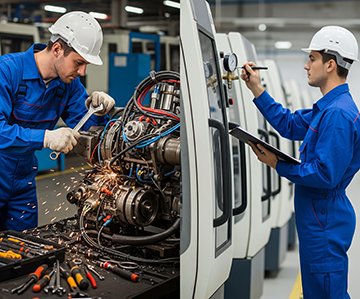Published: November 04, 2024 | Updated: October 20, 2025
Published: November 04, 2024 | Updated: October 20, 2025
Why Reactive Maintenance Still Exists — And When It's a Risk
 Why does reactive maintenance still exist? Maintenance strategy defines how efficiently facilities run, how often equipment fails, and how much operations cost over time. Among these strategies, reactive maintenance remains common despite evolving technology. Often labeled "run-to-failure," this approach waits for breakdowns before action. While widely used, the questions remain: Do you understand when it might be okay and when it's a risk?
Why does reactive maintenance still exist? Maintenance strategy defines how efficiently facilities run, how often equipment fails, and how much operations cost over time. Among these strategies, reactive maintenance remains common despite evolving technology. Often labeled "run-to-failure," this approach waits for breakdowns before action. While widely used, the questions remain: Do you understand when it might be okay and when it's a risk?
Understanding Reactive Maintenance
Reactive maintenance refers to the practice of servicing or replacing equipment only after a failure occurs. This reaction-based model attracts businesses due to its straightforward nature. It requires minimal planning, appears budget-friendly upfront, and suits environments with limited assets or staff. However, the long-term consequences often reveal serious gaps in preparedness, reliability, and efficiency.
Industries such as food processing, automotive manufacturing, and warehousing have historically leaned on reactive maintenance. In high-output environments, the instinct to "fix it when it breaks" can appear logical — especially when production deadlines dominate planning. But beneath the surface lies a volatile dependency on quick responses, emergency repairs, and short-term thinking.
Short-Term Gains: Why Reactive Maintenance Persists
Minimal Upfront Investment
The absence of scheduled interventions and software tools creates an appealingly low barrier to entry. For companies without significant capital or staffing, reactive maintenance can appear as the logical default. There are no costs related to preventive inspections, sensor systems, or labor dedicated to non-urgent repairs.
Simplicity in Operations
This model avoids the need for structured maintenance calendars or complex data analysis. Organizations focused solely on putting out fires can operate with limited staff, less training, and fewer technological tools. Smaller facilities or startups often adopt this approach while scaling their operations.
Flexibility with Labor and Inventory
Reactive environments shift labor and parts dynamically based on need. Technicians only address active failures, enabling leaner workforce schedules. Similarly, spare part usage only occurs when demand arises, reducing idle inventory costs—although this benefit has diminishing returns when breakdowns become frequent.
Some machines endure long periods without issues. Preventive maintenance, when misapplied, can trigger unnecessary interventions and costs. By reacting only when necessary, companies avoid tampering with equipment that might otherwise function without interruption.
Discover how streamlined maintenance processes can elevate production. Learn more.
The Cost of Waiting: Disadvantages of Reactive Maintenance
Unplanned Downtime
Production halts, delayed shipments, and missed deadlines often result from unpredictable failures. In manufacturing or logistics, even a few hours of downtime may cost tens of thousands of dollars. Equipment like conveyors or chillers, critical to continuous flow, can bring entire operations to a standstill when reactive strategies dominate.
Expensive Repairs and Emergency Costs
Failures rarely occur under ideal circumstances. Lack of planning means rush shipping for parts, after-hours labor charges, and limited technician availability. The combined result increases repair costs and disrupts budgets. Industries like oil and gas report repair costs up to five times higher when incidents aren't addressed proactively.
Reduced Equipment Reliability
Running assets to failure reduces their predictability and lifespan. Over time, the constant cycle of use and emergency repair creates unstable machinery that deteriorates faster. Even minor breakdowns can escalate due to unnoticed wear and tear, compromising adjacent systems.
Increased Safety Risks
Failure scenarios often include frayed electrical wires, leaking fluids, or broken safety guards. These events pose a significant risk to employees and operations. For example, in the chemical sector, a neglected seal on a pump can lead to environmental hazards and health violations. A reactive mindset heightens these dangers by missing critical early indicators.
Resource Imbalance and Morale Issues
Emergency repairs introduce chaos into team scheduling. Technicians face pressure to fix unexpected issues without adequate prep, often leading to burnout. Repeated crisis management decreases morale and strains collaboration between departments, especially when production lines halt due to avoidable problems.
The Role of CMMS in Transitioning to Preventive Maintenance
 Companies seeking stability and efficiency often turn to Computerized Maintenance Management Systems (CMMS) to transition from reactive methods. These digital tools track assets, generate work orders, and schedule preventive maintenance based on performance data and regulatory requirements.
Companies seeking stability and efficiency often turn to Computerized Maintenance Management Systems (CMMS) to transition from reactive methods. These digital tools track assets, generate work orders, and schedule preventive maintenance based on performance data and regulatory requirements.
Improved Asset Visibility
A CMMS logs each asset's location, service history, and component condition. This centralized information improves decision-making and eliminates the guesswork that drives reactive decisions. In facilities management, CMMS allows building engineers to detect performance dips early, long before they escalate to failures.
Automated Scheduling and Compliance Support
Preventive tasks are generated based on usage, time, or compliance standards. Organizations under strict regulation—such as pharmaceuticals or aviation—rely on CMMS platforms to document inspections, store reports, and maintain certification integrity.
Requests, assignments, and completions are handled digitally, reducing paperwork and lag. The system prioritizes tasks based on urgency, technician skills, and available inventory. A large hotel chain, for instance, reduced maintenance backlogs by 40% after CMMS implementation by clearly linking work orders to task categories and resolution times.
CMMS tracks inventory levels, flags critical spares, and helps automate purchasing. When parts fall below defined thresholds, new orders can be created automatically. Automotive plants benefit from this by minimizing downtime related to missing or mismanaged stockroom items.
Labor Planning and Skill Alignment
By mapping tasks to technician schedules, facilities reduce overtime and assign tasks more effectively. CMMS data reveals which employees perform which tasks most efficiently, making it easier to train and allocate future resources appropriately.
Safer, Smarter Operations
Routine maintenance reduces the likelihood of unsafe conditions. With CMMS systems tracking regulatory checks and scheduled repairs, organizations experience fewer workplace accidents and environmental compliance violations. This is especially critical in sectors such as energy, where safety breaches can lead to million-dollar fines and halted operations.
When Reactive Maintenance Makes Sense
Although often criticized, reactive maintenance isn't without value. For non-essential assets, rarely used machines, or low-budget scenarios, this approach can still function. Remote cell towers, rural electrical substations, or seasonal equipment often remain on a run-to-fail plan because of limited access or operating conditions. However, even in these cases, a CMMS can flag when failures become too frequent or when parts' costs begin to spiral.
Modern Industry Expectations
As industrial expectations shift toward predictive and preventive strategies, reliance on reactive methods continues to shrink. Industry 4.0 initiatives encourage sensor-based monitoring, digital twin modeling, and AI-driven maintenance forecasting. Companies unwilling to invest in predictive maintenance tools may find themselves falling behind competitors who operate with greater reliability, lower risk, and higher long-term profitability.
The Future of Maintenance: Data-Driven, Not Deadline-Driven
Facilities now compete not just on production but on efficiency, uptime, and safety. Those who build their operations on reactive principles face greater volatility and expense. In contrast, organizations leveraging CMMS and predictive insights gain a performance edge. With better data, informed decisions replace guesswork, and operations run with fewer disruptions. The transition might not happen overnight, but the direction forward is increasingly clear.
Stop Reacting, Start Evolving
Deciding whether to wait for equipment to break or prevent it from breaking determines more than just downtime. It shapes company culture, influences safety, affects profitability, and determines how adaptable an operation can be in the future. Tools now exist to make proactive maintenance not just achievable, but practical. Businesses that choose to evolve, rather than react, position themselves for stability and growth in an increasingly data-driven world.
Time to Rethink Maintenance for the Long Term
Reactive maintenance still finds use, but it's no longer the default for growth-driven organizations. Moving toward scheduled, strategic maintenance practices backed by CMMS technology provides resilience in volatile markets. Decisions made today about equipment care determine whether tomorrow's operations thrive or stall. The smart move is rarely the loudest or fastest—it's the one built to last.
FAQs
What is reactive maintenance and why do some companies still use it?
Reactive maintenance is the practice of fixing equipment only after it fails. Many companies still use it because it appears cheaper and simpler to manage in the short term.
What are the main risks of relying on reactive maintenance?
Reactive maintenance leads to unplanned downtime, expensive emergency repairs, safety issues, and reduced equipment reliability.
How can a CMMS help companies transition away from reactive maintenance?
A CMMS organizes maintenance schedules, tracks assets, and automates preventive tasks to minimize failures and increase uptime.
What advantages does MAPCON’s CMMS offer for preventive maintenance?
MAPCON’s CMMS improves asset visibility, automates scheduling, and tracks compliance to help organizations move from reactive to proactive maintenance.
When is reactive maintenance an acceptable strategy?
Reactive maintenance can be practical for non-critical assets, low-use equipment, or systems that are inexpensive to repair or replace.
Why should businesses replace reactive maintenance with data-driven systems?
Data-driven maintenance supported by CMMS software enhances safety, reduces costs, and boosts operational reliability over the long term.
MAPCON | 800-922-4336
MAPCON CMMS software empowers you to plan and execute PM tasks flawlessly, thanks to its wealth of features and customizable options. Want to see it for yourself? Click the button below to get your FREE 30-day trial of MAPCON!
Try It FREE!